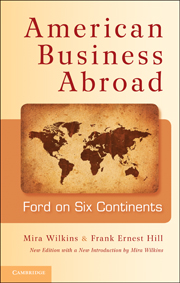Book contents
- Frontmatter
- Contents
- List of Illustrations
- Preface
- Introduction to the New Edition
- Introduction to the First Edition
- 1 First Venture
- 2 Probing for Markets
- 3 Model T: Triumph and Fable
- 4 The Alchemy of War
- 5 Steps in Expansion
- 6 The Sun Never Sets
- 7 Prosperity and Frustration
- 8 The Missionary Spirit
- 9 The Best-Laid Plans
- 10 Marriage of Convenience
- 11 Time of Desperation
- 12 A World Disturbed
- 13 Extreme of Nationalism
- 14 The British Empery
- 15 On Both Sides of World War II
- 16 The Crippled Phoenix
- 17 The New Company
- 18 Manufacturing for World Markets: From Dagenham to Geelong
- 19 New Times, New Faces, New Policies
- Appendices
- Bibliographical Essay
- Notes
- Index
- Titles in the series
- Plate section
3 - Model T: Triumph and Fable
Published online by Cambridge University Press: 05 June 2012
- Frontmatter
- Contents
- List of Illustrations
- Preface
- Introduction to the New Edition
- Introduction to the First Edition
- 1 First Venture
- 2 Probing for Markets
- 3 Model T: Triumph and Fable
- 4 The Alchemy of War
- 5 Steps in Expansion
- 6 The Sun Never Sets
- 7 Prosperity and Frustration
- 8 The Missionary Spirit
- 9 The Best-Laid Plans
- 10 Marriage of Convenience
- 11 Time of Desperation
- 12 A World Disturbed
- 13 Extreme of Nationalism
- 14 The British Empery
- 15 On Both Sides of World War II
- 16 The Crippled Phoenix
- 17 The New Company
- 18 Manufacturing for World Markets: From Dagenham to Geelong
- 19 New Times, New Faces, New Policies
- Appendices
- Bibliographical Essay
- Notes
- Index
- Titles in the series
- Plate section
Summary
The Ford Motor Company had purchased in April 1907 a 57-acre tract of land in Highland Park, a few miles north of Detroit, for $81,225, to expand the manufacture of its car. The act was revolutionary. Its old plant on Piquette Avenue, Detroit, which it proposed to abandon, occupied 2.65 acres; Henry Ford was probably right when he said later: “It was as good as, perhaps a little better than, any automobile factory in the country.” He recalled that people were asking, “How soon will Ford blow up?”
Ford officials could smile at that query. They had paid their shareholders fabulous sums on the original capitalization of $100,000, and in 1908 would declare $2,500,000 in regular and stock dividends. During that year they would also produce 10,607 cars, which gave them first place among automobile manufacturers in the United States, and in the next year would almost double this sale, repeating the achievement in 1910–1911 with 34,528 vehicles. Moreover, they stood high in an American industry that in 1910 put out 181,000 cars to 64,000 for France, England, and Germany combined—the outstanding automotive countries of Europe.
In September 1908 William C. Durant united the Olds and Buick firms to form the General Motors Company, to which Oakland and Cadillac were added the following year. Ford lost first place as this powerful combination in 1909 made dollar sales thrice those of Ford.
- Type
- Chapter
- Information
- American Business AbroadFord on Six Continents, pp. 35 - 59Publisher: Cambridge University PressPrint publication year: 2011

